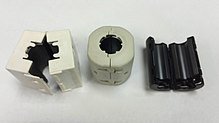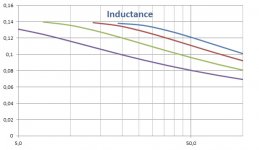No need to get rude.
It's not rude. It's just a common phrase, this side of the pond anyway...
Listening while peeking, right?Speculation is all we really need! The proof is in the listening.
“ Interesting theory and possible mechanism for AC powered equipment, however IME I find just now that clamping a ferrite around headphone cable connected to cell phone (battery powered and floating) playing Youtube dialogue causes change in sound with change in mids and empahasis on essing and 'hardening' of the overall sound, also sounding as though recording has been 'sped up' slightly.”
Really? I’m trying to work out how a common mode ferrite clamp placed around a headphone cable where the source is floating ie battery powered can have any audible effect.
There is no common mode return path for any signal other than potential capacitive coupling but that would be pretty much zero in any normal environment.
Really? I’m trying to work out how a common mode ferrite clamp placed around a headphone cable where the source is floating ie battery powered can have any audible effect.
There is no common mode return path for any signal other than potential capacitive coupling but that would be pretty much zero in any normal environment.
Evidently the ferrite clamp has more than only CM effect.Really? I’m trying to work out how a common mode ferrite clamp placed around a headphone cable where the source is floating ie battery powered can have any audible effect.
Try it for yourself and take a close listen and you ought to hear the changes and once you have heard them you might find explanation.
As further subjective description you might note that for example room reverb sounds decay faster leaving clearer audio BUT with change in overall timbre and emphasis in ESS sounds.
I am aware of such confounder, I was careful to place the phone on the table with the cable draping through space and not touching my body or anything else.There is no common mode return path for any signal other than potential capacitive coupling but that would be pretty much zero in any normal environment.
Last edited:
There is no common mode return path for any signal other than potential capacitive coupling but that would be pretty much zero in any normal environment.
The ferrite cores are not perfect transformers. So from a headphone driver source of perhaps 100 ohms there will be some coupled load that might be affected by the magnetically coupled hysteresis.
Now it is in the realm of possibility that a human could perceived that distortion, just not very probable. But then it is speculation as to if the perceiver is human!
Armed with that experience, they then think they found hysteresis distortion in the output inductor of their class-D power amps. The are using super fast switching transistors now, so they are able to use an air core inductor at the higher switching freqeuncies (unlike Bruno's last generation of class D amps).
AFAIK, Purifi and Ncore use similar switching frequencies, the former being 500kHz and the latter 430kHz.
Having said that they probably have moved to GaN MOSfets which should
have improved performance.
Understanding all that, they think (1) class-D amps are audibly different, (2) they think using a low distortion speaker makes it easier to hear the audible differences between class-D amps, and (3) they think the iron core output inductor found in most class-D amps (like in Bruno's other amp company) is probably responsible for most of the audible distortion produced by the amp.
Have you tried any decent Class D amps in your system? The Purifi amps look incredible spec wise. Putzeys is a genius.
TCD
The ferrite cores are not perfect transformers. So from a headphone driver source of perhaps 100 ohms there will be some coupled load that might be affected by the magnetically coupled hysteresis.


I am using Galaxy S5 phone as source driving ATH-AG1 headphones rated 38ohms load impedance and industry standard clip-on type ferrite split core noise filter.
I don't understand your use of the term transformer in this context ?.
These mega headphones I am using have 53mm drivers and are rated 5Hz-35kHz and they sound it when worn ie unusually clean clear and extended lows and highs and they also make good tabletop loudspeakers in quiet environment.Now it is in the realm of possibility that a human could perceived that distortion, just not very probable. But then it is speculation as to if the perceiver is human!
This Psychoacoustics video is full of suitable esss sounds and the differences in playback sound with or without ferrite filter is pretty clear with headphones worn or on the tabletop and I dare say with training would pass ABX .
I find it quite interesting that from all this lengthy Lars Risbo & Bruno Putzeys interview (plus the reference material at the bottom) that Bill promptly linked to in post # 3071 which is about engineering solutions thought of by those two and used to optimize class D operation, the bring up point here is magnetic hysteresis distortion and magnetic domain unlock noise.
Are poor ferrite cores the last new emperor or is it that all the other technical points there are a no-no here?
George
Are poor ferrite cores the last new emperor or is it that all the other technical points there are a no-no here?
George
Speculation is all we really need!
Absolutely revealing. Charlatan's creed.
> The proof is in the listening.
There is no proof, only potential market share by rigged demo.
I find it quite interesting that from all this lengthy Lars Risbo & Bruno Putzeys interview (plus the reference material at the bottom) that Bill promptly linked to in post # 3071 which is about engineering solutions
Ah but matlab scripts that optimise control loops doesn't give a mystique! 75dB of negative feedback that remains stable is impressive in a power amplifier.
Easy to do at LF. The problem comes at HF but how the hell you do that in an amp that has a dirty big inductor on the output plus a hugely reactive load beats me.
All respect the man 🙂
All respect the man 🙂
Here is the IP contribution of these two gentlemen.
Bruno Putzeys
FPO IP Research & Communities
Lars Risbo
FPO IP Research & Communities
George
Bruno Putzeys
FPO IP Research & Communities
Lars Risbo
FPO IP Research & Communities
George
It almost seems as if every molecule of a class D amp, inside and outside, has been claimed and protected.Here is the IP contribution of these two gentlemen.
Bruno Putzeys
FPO IP Research & Communities
Lars Risbo
FPO IP Research & Communities
George
Poor competitors 😀
Hans
Well, Gerhard, the Max Planck of over 100 years ago had his share of critics at the time, as well. And it would be people like you who would challenge him as well. Where are those critics today, I wonder? '-)
Besides increased noise (Barkhausen noise), the direct audible affect of hysteresis itself is a lot like the DA in Caps. Both dont measure much in THD tests. But compared to air core and low DA caps, respectively, there is an audible effect when the hyster and DA is large enough.
Bad analogy, magnetic hysteresis gives rise to level dependent frequency response enough to be easily measured and actually audible. Of course when you look at a sine wave you only see the slight compressive distortion. Did anyone think to look at an L/R/C filter, for instance, that has 6dB attenuation for a 0dBV input but only 5dB of attenuation for a -6db input? It's known as lots of AM IMD distortion that does not show up on a single amplitude sine wave test.
DA is not level dependent for any capacitor that one would actually use, Bob Pease showed this years ago. The effects of DA are minuscule frequency response deviations, typically 100ths of a dB.
Bad analogy, magnetic hysteresis gives rise to level dependent frequency response enough to be easily measured and actually audible. Of course when you look at a sine wave you only see the slight compressive distortion. Did anyone think to look at an L/R/C filter, for instance, that has 6dB attenuation for a 0dBV input but only 5dB of attenuation for a -6db input? It's known as lots of AM IMD distortion that does not show up on a single amplitude sine wave test.
That effect is what Demian just clearly measured for an ESL63 transformer.
Horizontal from 5 to 100Hz, vertical the measured inductance for 4 different levels, from top to bottom resp. 4, 2, 1.25 and 0.6 Volt.
Hans
Attachments
Max Planck and Ed:
Nonsense
Let’s leave it at that.
Bon...
It is a measurable amount of distortion just from running wires inside a steel chassis. Just depends on length, proximity and impedance. Nothing new there. As to the headphone tale, as the core is not acting as a complete circuit (transformer action) it is possible to induce distort.
I think you misunderstood my coment on human perception thresholds. It probably is possible to design a headphone, ferrite core and drive source to bring the issue to a humanly perceptable level. However I suspect perceiving this kind of distortion is more a sport of seeing what you can do to screw up things.
Do keep in mind the type of clamp on core is intended to probide noise filtering on an AC power cord. I have seen dimmable podium incandescent lights cause hum and buzz into the microphone mounted on the same podium. Not really surprising understanding how such small dimmers work, including that they do not include noise reducing inductors in such small gizmos.
Not surprisingly adding a single ferrite core to dimmed lamp's power cord reduces the noise in the microphone circuit. This is influencing a 120 Hz plus many harmonics noise source. Practical fixes require twisting the AC power cord looping it several times through the ferrite core, using a few of them and even putting a core on the microphone line.
Conclusion is that some ferrite core noise filters do have some effect at quite low frequencies. Thus with a bit of effort you can screw up a headphone cable!
That effect is what Demian just clearly measured for an ESL63 transformer.
Good use of a multi tone test.
- Home
- Member Areas
- The Lounge
- The Black Hole......
